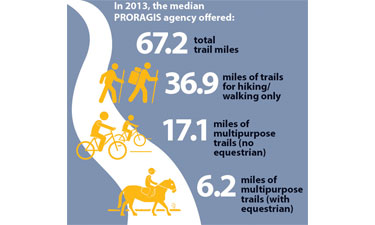 While he was secretary of transportation for the United States, Ray LaHood said, “Livability means being able to take your kids to school, go to work, see a doctor, drop by the grocery or post office, go out to dinner and a movie, and play with your kids at a park — all without having to get in your car.” Perhaps without knowing it, Secretary LaHood was making a clear case for the importance of park and recreation agencies in building livable communities. Public park and recreation agencies are critical components in the implementation of active transportation principles, and the benefits of active transportation as they relate to economic, health and conservation issues are massive. Analysis of the data in PRORAGIS™ shows that in 2013, the median mileage of greenways and trails managed by PRORAGIS agencies was more than 67 miles. From this data, we can infer that park and recreation agencies already manage hundreds of thousands of miles of trails that people use to commute, exercise and move between locations that are important in their lives. Interestingly, the median percentages of trails that are multipurpose in nature, where bikers, walkers, runners and sometimes even equestrians share the path, are more than 70 percent. As many professionals familiar with shared-use trails will tell you, this is a very common source of friction between citizens and can present challenges to successful deployment of active transportation strategies.
While he was secretary of transportation for the United States, Ray LaHood said, “Livability means being able to take your kids to school, go to work, see a doctor, drop by the grocery or post office, go out to dinner and a movie, and play with your kids at a park — all without having to get in your car.” Perhaps without knowing it, Secretary LaHood was making a clear case for the importance of park and recreation agencies in building livable communities. Public park and recreation agencies are critical components in the implementation of active transportation principles, and the benefits of active transportation as they relate to economic, health and conservation issues are massive. Analysis of the data in PRORAGIS™ shows that in 2013, the median mileage of greenways and trails managed by PRORAGIS agencies was more than 67 miles. From this data, we can infer that park and recreation agencies already manage hundreds of thousands of miles of trails that people use to commute, exercise and move between locations that are important in their lives. Interestingly, the median percentages of trails that are multipurpose in nature, where bikers, walkers, runners and sometimes even equestrians share the path, are more than 70 percent. As many professionals familiar with shared-use trails will tell you, this is a very common source of friction between citizens and can present challenges to successful deployment of active transportation strategies.
The importance of trails as part of a comprehensive transportation strategy is reflected in provisions in the recent Grow America legislation proposed by the Obama administration. While this overarching strategy for surface transportation is unlikely to make it through Congress in its current form, the components focusing on active transportation issues provide insight into the future of how active transportation will be a part of comprehensive strategies to make moving around our cities more efficient, equitable and enjoyable. As such, NRPA is in the process of refreshing our summary of the close relationship of parks and recreation and active transportation through the lens of NRPA’s three pillars of conservation, health and wellness, and social equity. This updated monograph will be released later this year, and with a bit of luck will serve as a resource as your agency continues to bring the benefits of active transportation to your citizens.
Travis Smith, Ph.D., is NRPA’s Director of Research.

